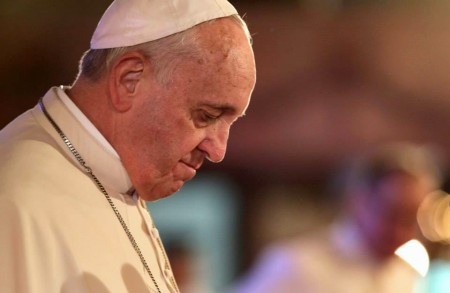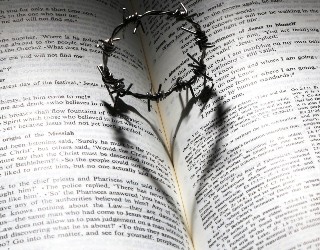 Hi readers, it seems you use Catholic Online a lot; that's great! It's a little awkward to ask, but we need your help. If you have already donated, we sincerely thank you. We're not salespeople, but we depend on donations averaging $14.76 and fewer than 1% of readers give. If you donate just $5.00, the price of your coffee, Catholic Online School could keep thriving. Thank you. Help Now >
Hi readers, it seems you use Catholic Online a lot; that's great! It's a little awkward to ask, but we need your help. If you have already donated, we sincerely thank you. We're not salespeople, but we depend on donations averaging $14.76 and fewer than 1% of readers give. If you donate just $5.00, the price of your coffee, Catholic Online School could keep thriving. Thank you. Help Now >
30 YEARS AFTER CHALLENGER - What happened to the crew? Why do we go to space?
FREE Catholic Classes
On January 28, 1986, Americans watched as space shuttle Challenger left the launch pad at Kennedy Space Center in Florida with seven astronauts aboard, including the first ordinary civilian. Just over a minute later, we watched in horror as seven lives abruptly ended in one of the most iconic disasters of space-faring history. Almost every American alive at that time, remembers where they were when they heard the news.
Highlights
CALIFORNIA NETWORK (https://www.youtube.com/c/californianetwork)
1/28/2016 (8 years ago)
Published in U.S.
Keywords: Challenger, Christa McAullife, disaster, tragedy, NASA, cause, crew, fate
LOS ANGELES, CA (California Network) - The Challenger explosion was instantly seared into the collective memory of millions of Americans on that bright, frosty January morning. The vision of two solid rocket boosters rising from the fireball like the horns of a bull marks the moment Americans realized space travel had a human price.
Making the loss especially traumatic was the death of schoolteacher Christa McAuliffe, who won a contest to become the first ordinary citizen to go into space. Shuttle launches had become routine, but her inclusion on the mission brought renewed public interest. For the first time in a long while, television networks broke into regular programming to show her ride into space, unwittingly giving Americans a front-row seat to disaster.
Challenger exploded just after a minute into its ascent. An investigation revealed the grisly details about the crew's fate. America heard the words, "Challenger, go throttle up!" but that wasn't the last voice heard from the shuttle. "An alarmed "uh oh," from pilot, Michael Smith" was heard in the control room as electronic data was lost. It suggested the fate of the crew was neither swift nor merciful.
The explosion that destroyed Challenger was caused by a cracked seal on a solid rocket booster, far behind the crew cabin, near the craft's base. Frosty conditions caused a special gasket to become fragile. When subjected to the sudden heat of ignition, it cracked, allowing hot gasses to form an exhaust plume. That plume was hidden from view by the orientation of the spacecraft to most ground-based cameras.
Eventually, that plume caused an explosion in the massive, brown, main fuel tank, which also blew up the Challenger, mounted on its back. As the shuttle broke up, one part remained intact --the crew compartment.
The crew compartment almost certainly protected the crew from the brunt of the explosion. In fact, it's unlikely they were seriously injured, according to Dr. Joseph P. Kerwin, Director of Life Sciences at Johnson Space Center. His report made clear that the explosion would not have hardly effected the crew. In other words, the crew easily survived the explosion.
Although the altitude could have knocked the crew unconscious within seconds, recovery experts found at least three of the astronauts had activated their emergency oxygen tanks, something which had to be done manually.
The report concluded the crew was likely coherent for much of their fall back to Earth. Their deaths were finally caused by impact with the ocean, almost three minutes later.
The details of the crew's fate has been suppressed for three decades, largely obscured by uncertainty. The crew compartment was discovered in a hundred feet of water after exploding and falling from an altitude of 65,000 feet, then crashing into the sea. But it was relatively intact, so the grim calculus suggests they weren't knocked out by the explosion, and there was likely enough air pressure to maintain consciousness for several seconds, or longer. These horrifying details were not widely publicized at the time.
The aftermath of the disaster sparked a national debate about the safety of human spaceflight. Indeed, NASA officials were found to be careless and to have played a dangerous game of chance with the Challenger launch. As a whole the nation had to consider if the price of human spaceflight was worth the cost. Why do we do it?
The answer is simple. We can't stay put. Our very genes express the compulsion to explore, and to seek new horizons.
The resounding response, once most of the tears had dried, was yes, we must continue. Humanity never advanced by backing away from the dangers inherent in exploration. NASA's human space program resumed after 18 months and many changes later.
In 2003, another disaster struck with the loss of the shuttle Columbia. This loss was caused by a large chunk of insulating foam which broke off the external fuel tank under the vibration of launch and struck the heat-resistant tiles on Columbia's belly with the force of a bullet. The resulting hole allowed plasma to compromise the structural integrity of the shuttle on reentry. Another seven astronauts were lost in a high-profile disaster.
The shuttle program in now long retired, the surviving vehicles are museum pieces. The risk they brought was simply too much to bear, at least politically. NASA is now returning to rockets, which should be simpler and safer and will begin carrying humans within the next few years.
The loss of Challenger is fading into distant memory for most, since eclipsed by 9/11 and the other concerns of our day. Nonetheless, we cannot help but see the date on the calendar and think back to where we were and what we were doing when we heard the jarring news on that frosty January morning.
We know we must go, we cannot stop.
---
The California Network is the Next Wave in delivery of information and entertainment on pop culture, social trends, lifestyle, entertainment, news, politics and economics. We are hyper-focused on one audience, YOU, the connected generation. JOIN US AS WE REDEFINE AND REVOLUTIONIZE THE EVER-CHANGING MEDIA LANDSCAPE.
We ask you, humbly: don't scroll away.
Hi readers, it seems you use Catholic Online a lot; that's great! It's a little awkward to ask, but we need your help. If you have already donated, we sincerely thank you. We're not salespeople, but we depend on donations averaging $14.76 and fewer than 1% of readers give. If you donate just $5.00, the price of your coffee, Catholic Online School could keep thriving. Thank you.Help Now >








 Daily Readings for Saturday, April 20, 2024
Daily Readings for Saturday, April 20, 2024 St. Marian: Saint of the Day for Saturday, April 20, 2024
St. Marian: Saint of the Day for Saturday, April 20, 2024 Children's Prayer For Parents: Prayer of the Day for Saturday, April 20, 2024
Children's Prayer For Parents: Prayer of the Day for Saturday, April 20, 2024

